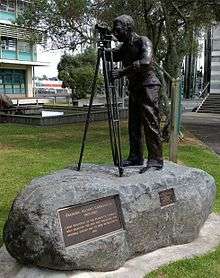Frederic Carrington
| Frederic Carrington | |
|---|---|
 Statue of Frederic Carrington at Robe Street Lawn, New Plymouth | |
| Born |
11 October 1807 Chelmsford, Essex |
| Died |
15 July 1901 (aged 93) New Plymouth, New Zealand |
| Known for | Founding survey of New Plymouth |
Frederic Alonzo Carrington (Oct 1807[1] – 15 July 1901) was a 19th-century New Zealand politician and surveyor. He is regarded as the Father of New Plymouth.
Carrington was born in Chelmsford, Essex, England in 1807, the son of Captain William Carrington.[1]
He was 15 years in the Ordnance Survey Department. Then he was appointed by the New Zealand Company as Chief Surveyor to the Plymouth Company and surveyed the new settlement of New Plymouth. He arrived in Wellington with his family in the ship London in December 1840 as a cabin passenger.[2]
In 1844, he returned to England, and undertook surveying for parliamentary committees in England and Scotland. In 1851, he displayed iron made from Taranaki iron sand at The Great Exhibition, London.[1] From 1851 to 1856 he investigated business proposals in California and other parts of America, Paris and Belgium.[3]
He left for New Zealand with his family in January 1857 and in 1862 was made Government Engineering Surveyor for Taranaki.[1] He finally obtained a grant of land in 1877.
| New Zealand Parliament | ||||
| Years | Term | Electorate | Party | |
| 1870 | 4th | Omata | Independent | |
| 1871–1875 | 5th | Grey and Bell | Independent | |
| 1875–1879 | 6th | Grey and Bell | Independent | |
He was Superintendent of Taranaki Province from 1869 to 1876 (when the Provinces were abolished),[4] and was the member of Parliament for Omata in 1870 and then Grey and Bell from 1871 to 1879 when he retired.[5] He was a member of the Harbour Board (now Port Taranaki), and an advocate of an adequate harbour for New Plymouth. In 1881, Carrington laid the first stone for the main breakwater at the port, using a trowel made from Taranaki ironsand.[6]
Carrington died in New Plymouth[3] and is buried in the family grave in Te Henui Cemetery.[1]
Carrington Street, a New Plymouth arterial route, and its extension Carrington Road, which winds between the Pouakai and Kaitake ranges, are named for him. He is regarded as the father of New Plymouth.[3]
Notes
- 1 2 3 4 5 "Obituary Mr F A Carrington". Taranaki Herald. 15 July 1901. p. 2.
- ↑ "London". Rootsweb. Retrieved 28 September 2013.
- 1 2 3 Tullett, J. S. "Carrington, Frederic Alonzo". Dictionary of New Zealand Biography. Ministry for Culture and Heritage. Retrieved 28 September 2013.
- ↑ Scholefield 1950, p. 229.
- ↑ Wilson 1985, p. 188.
- ↑ "The Ceremony of Laying the Stone". Taranaki Herald. 8 February 1881. p. 2.
References
- Wilson, James Oakley (1985) [First published in 1913]. New Zealand Parliamentary Record, 1840–1984 (4th ed.). Wellington: V.R. Ward, Govt. Printer. OCLC 154283103.
- Scholefield, Guy (1950) [First published in 1913]. New Zealand Parliamentary Record, 1840–1949 (3rd ed.). Wellington: Govt. Printer.
| Political offices | ||
|---|---|---|
| Preceded by Henry Robert Richmond |
Superintendent of Taranaki Province 1869–1877 |
Provincial Councils abolished |
| New Zealand Parliament | ||
| Preceded by Charles Brown |
Member of Parliament for Omata 1870 |
Constituency abolished |
| Preceded by James Crowe Richmond |
Member of Parliament for Grey and Bell 1871–1879 |
Succeeded by Robert Trimble |